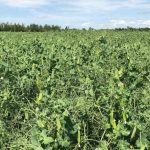
Pulses

Anti-dumping case may affect pea flow
A U.S. duty on Chinese pea protein could reduce the amount of peas that China imports for its fractionation business, which Canada feeds into

Pulse sector welcomes federal funds
AAFC announces $11 million in funding for Pulse Canada

Faba bean research means high protein, less gas
The process of breaking down faba beans is an important sustainability tool, scientist says

Managing pulses when the well runs dry
Growers urged to watch seeding depth, rate and crop rotations

Pulse weekly outlook: Pea exports solid so far, lentils down on year

Pulse weekly outlook: Activity to ramp up for chickpeas
'Quality was good, yields were lower'

Pulse weekly outlook: Smaller North American dry bean crops to underpin prices
Canada's edible bean crop estimated smallest since 2016

Pulse weekly outlook: Smaller yields than last year in Saskatchewan
Pulse production seen varying by location

Pulse weekly outlook: ‘Average’ dry bean crop in Manitoba
Won't be close to last year's 'pretty phenomenal' crop

Bean crops take yield hit
Lack of summer rains lowered early harvest soybean and dry bean yields, judging by the first beans to hit the bin
HARVEST Lack of summer rains lowered early harvest soybean and dry bean yields, judging by the first beans to hit the bin
Acres are up but yields are trending down for soybeans and dry beans across the province this year, according to Manitoba Agriculture pulse specialist Dennis Lange. “The key word this year is variability,” he said. “It all depends on when you got that rain, or if you got that rain. “If you got that rain, generally, harvest

